Lights Over lapland is excited to announce that Autumn Aurora Adventures are available for immediate booking! Reserve your adventure of a lifetime in Abisko National Park, Sweden today! | | |
SUNSPOT OF INTEREST: Sunspot AR2671 is sprawling across the surface of the sun, more than 100,000 miles wide. This makes it an easy target for solar telescopes trained on the sun during next Monday's solar eclipse. Observers might catch a solar flares; the sunspot has a 'beta-gamma' magnetic field that harbors energy for M-class explosions. Free: Solar Flare Alerts
AURORA SEASON BEGINS: In the Lapland of northern Finland, photographer B.Art Braafhart has been waiting four long sunny months to see the auroras again. Last night, they returned. "It was a super start to the new aurora season," says Braafhart, who took this picture just after midnight on Aug. 18th:
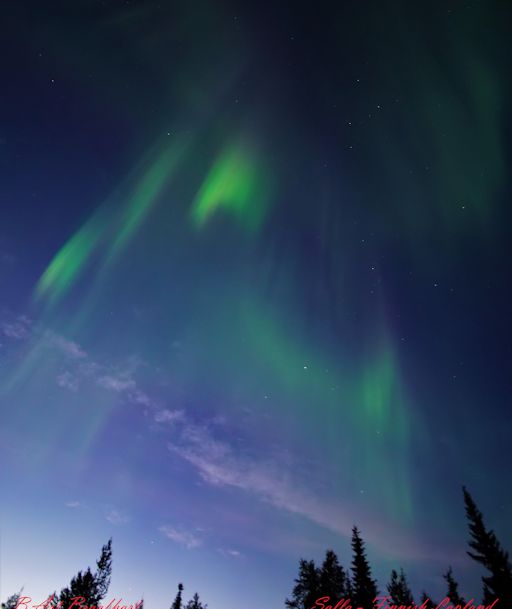
"The sky overhead was decorated with a bright green bow, soon exploding into a colorful corona and other shapes," says Braafhart. "In the north-northeast, the colors of the sunset mixed beautifully with the auroras."
More auroras are in the offing as the midnight sun wanes into autumn darkness. In fact, they could come again tonight. A high-speed stream of solar wind is blowing around our planet. As a result, NOAA forecasters say there is a 50% chance of polar geomagnetic storms on Aug. 19th. Aurora season has begun! Free: Aurora Alerts
Realtime Aurora Photo Gallery
PREDICTING THE ECLIPSE: During a total eclipse, one of the most mesmerizing sights is the sun's ghostly corona. Gossamer streamers of gas in the sun's outer atmosphere suddenly become visible when the disk of the Moon blocks the glaring body of the sun. NASA-supported researchers at Predictive Science Inc. have just issued a computer model showing how the corona should look to the human eye on Aug.21st, the date of the Great American Solar Eclipse:
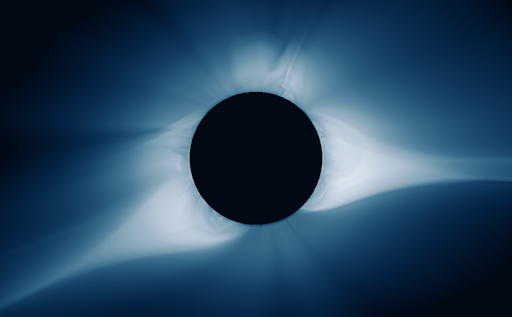
"The sun's outer atmosphere is not a featureless layer of gas," says Pete Riley, a solar physicist at the company. "It is sculpted into beautiful, dynamic shapes by the sun's magnetic field." Riley and colleagues including Zoran Mikic and Cooper Downs figured out how to calculate and predict those shapes.
"Every day, NASA's Solar Dynamics Observatory measures magnetism at the surface of the sun," explains Mikic, who led the modeling effort. "We take the data and extrapolate it into the atmosphere using a computer running magnetohydrodynamic (MHD) codes."
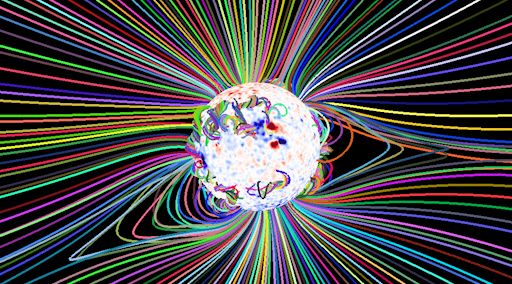
Magnetic fields in the sun's atmosphere, calculated by the Predictive Science MHD code [more]
The result is a physics-based prediction of what people and cameras could see within the path of totality. "We are eager to find out how well our model results match reality," says Riley. "Ultimately, this may yield new insight into the complex physical processes that heat the solar corona and accelerate the solar wind."
Riley invites readers to return to their web site after the eclipse for a comparison of the predictions with actual observations. "Enjoy the eclipse!" he says.
Realtime Space Weather Photo Gallery
SOLAR ECLIPSE PENDANTS: Would you like to support our Solar Eclipse Balloon Network? Here's one way: Buy a space pendant. This solar eclipse-themed necklace flew to the stratosphere on July 2, 2017, attached to the payload of an Earth to Sky Calculus space weather balloon:
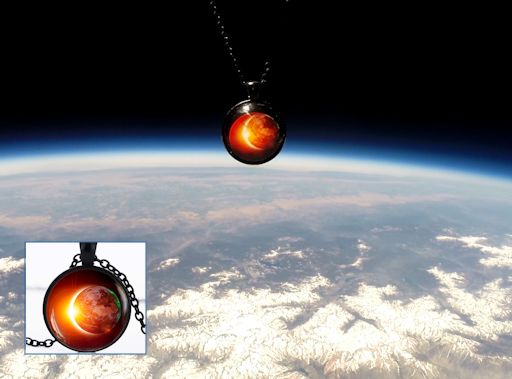
The payload contained more just like it. If you buy one now for $99.95, we will fly it back to the stratosphere during the Great American Solar Eclipse on August 21, 2017, where it will be enveloped by the Moon's cool shadow above our launch site in Oregon. No additional charge! Just make a note in the COMMENTS BOX of the shopping cart: "Please fly my pendant into the eclipse!" Each pendant comes with a greeting card showing the jewelry in flight and telling the story of its journey to the stratosphere and back again.
More items from the edge of space may be found in the Earth to Sky Store. All proceeds support atmospheric radiation monitoring and hands-on STEM education.
Far Out Gifts: Earth to Sky Store
All proceeds support hands-on STEM education
WHY GO TO THE PATH OF TOTALITY? On Aug. 21, 2017, every square inch of the USA will experience a solar eclipse. In most places, the eclipse will be partial--that is, the Moon will cross the sun off-center leaving only a crescent-shaped portion of the solar disk exposed. Is it really worth the trip to the path of totality when you can see most of the sun covered from the comfort of your own home? Pulitzer prize winner Annie Dillard witnessed both types of eclipse in 1979, and her comparison might help you make up your mind:
"A partial eclipse is very interesting. It bears almost no relation to a total eclipse. Seeing a partial eclipse bears the same relation to seeing a total eclipse as kissing a man does to marrying him, or as flying in an airplane does to falling out of an airplane."
During the minutes of totality, the whole world changes. Saying that day turns into night barely scratches the surface of it. The shadow of the Moon lances down to Earth from a quarter million miles away. On one end is you; on the other end is a million square miles of dusty lunar terrain. You're connected, and you can feel the cold.
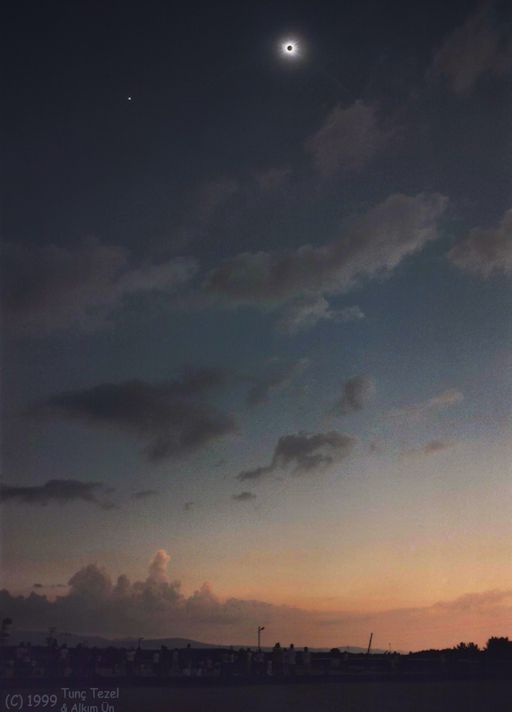
Image Credit & Copyright: Tunç Tezel (TWAN), Alkim Ün
Darkness inside the path of totality has an alien quality. Because the shadow is only 70 miles wide, you can see daylight at the edges even while you stand in the dark core. This distant scattered light produces a slight reddish glow and unusual shadow effects. Many birds stop singing, daytime flower blossoms begin to close as if for the night, and bees return to their hives.
"What you see in an eclipse is entirely different from what you know," says Dillard, whose brilliant essay "Total Eclipse" is a must-read for anyone deciding whether to stay home ... or have their minds blown.
Realtime Eclipse Photo Gallery
Realtime Noctilucent Cloud Photo Gallery
Every night, a network of
NASA all-sky cameras scans the skies above the United States for meteoritic fireballs. Automated software maintained by NASA's Meteoroid Environment Office calculates their orbits, velocity, penetration depth in Earth's atmosphere and many other characteristics. Daily results are presented here on Spaceweather.com.
On Aug. 18, 2017, the network reported 76 fireballs.
(67 sporadics, 7 Perseids, 2 Northern delta Aquariids)

In this diagram of the inner solar system, all of the fireball orbits intersect at a single point--Earth. The orbits are color-coded by velocity, from slow (red) to fast (blue). [Larger image] [movies]
Potentially Hazardous Asteroids (
PHAs) are space rocks larger than approximately 100m that can come closer to Earth than 0.05 AU. None of the known PHAs is on a collision course with our planet, although astronomers are finding
new ones all the time.
On August 18, 2017 there were 1803 potentially hazardous asteroids.
 |
Recent & Upcoming Earth-asteroid encounters: | Asteroid | Date(UT) | Miss Distance | Velocity (km/s) | Diameter (m) |
| 2014 OA339 | 2017-Aug-13 | 12.3 LD | 10 | 47 |
| 2017 PK25 | 2017-Aug-14 | 2.2 LD | 16 | 31 |
| 2017 PD25 | 2017-Aug-16 | 9.7 LD | 7.9 | 32 |
| 2017 PV25 | 2017-Aug-22 | 5.5 LD | 6.5 | 41 |
| 2017 PE | 2017-Aug-24 | 19.5 LD | 7.1 | 45 |
| 2017 PL26 | 2017-Aug-28 | 14.2 LD | 8.4 | 131 |
| 3122 | 2017-Sep-01 | 18.5 LD | 13.5 | 5376 |
| 2017 OP68 | 2017-Sep-10 | 20 LD | 11.7 | 296 |
| 2014 RC | 2017-Sep-11 | 15.1 LD | 8.9 | 16 |
| 2017 PR25 | 2017-Sep-23 | 17.9 LD | 13.5 | 224 |
| 1989 VB | 2017-Sep-29 | 7.9 LD | 6.3 | 408 |
| 2012 TC4 | 2017-Oct-12 | 0.1 LD | 7.6 | 16 |
| 2005 TE49 | 2017-Oct-13 | 8.5 LD | 11.2 | 16 |
| 2013 UM9 | 2017-Oct-15 | 17 LD | 7.8 | 39 |
Notes: LD means "Lunar Distance." 1 LD = 384,401 km, the distance between Earth and the Moon. 1 LD also equals 0.00256 AU. MAG is the visual magnitude of the asteroid on the date of closest approach. | | Cosmic Rays in the Atmosphere |
Readers, thank you for your patience while we continue to develop this new section of Spaceweather.com. We've been working to streamline our data reduction, allowing us to post results from balloon flights much more rapidly, and we have developed a new data product, shown here:

This plot displays radiation measurements not only in the stratosphere, but also at aviation altitudes. Dose rates are expessed as multiples of sea level. For instance, we see that boarding a plane that flies at 25,000 feet exposes passengers to dose rates ~10x higher than sea level. At 40,000 feet, the multiplier is closer to 50x. These measurements are made by our usual cosmic ray payload as it passes through aviation altitudes en route to the stratosphere over California.
What is this all about? Approximately once a week, Spaceweather.com and the students of Earth to Sky Calculus fly space weather balloons to the stratosphere over California. These balloons are equipped with radiation sensors that detect cosmic rays, a surprisingly "down to Earth" form of space weather. Cosmic rays can seed clouds, trigger lightning, and penetrate commercial airplanes. Furthermore, there are studies ( #1, #2, #3, #4) linking cosmic rays with cardiac arrhythmias and sudden cardiac death in the general population. Our latest measurements show that cosmic rays are intensifying, with an increase of more than 13% since 2015:
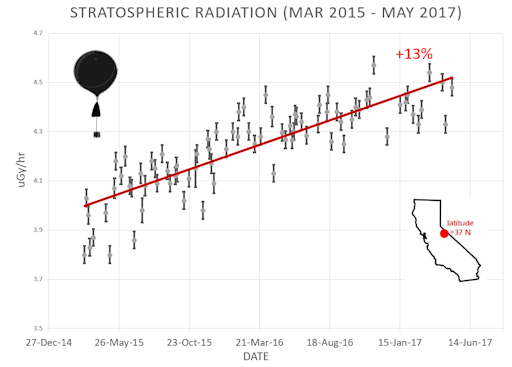
Why are cosmic rays intensifying? The main reason is the sun. Solar storm clouds such as coronal mass ejections (CMEs) sweep aside cosmic rays when they pass by Earth. During Solar Maximum, CMEs are abundant and cosmic rays are held at bay. Now, however, the solar cycle is swinging toward Solar Minimum, allowing cosmic rays to return. Another reason could be the weakening of Earth's magnetic field, which helps protect us from deep-space radiation.
The radiation sensors onboard our helium balloons detect X-rays and gamma-rays in the energy range 10 keV to 20 MeV. These energies span the range of medical X-ray machines and airport security scanners.
The data points in the graph above correspond to the peak of the Reneger-Pfotzer maximum, which lies about 67,000 feet above central California. When cosmic rays crash into Earth's atmosphere, they produce a spray of secondary particles that is most intense at the entrance to the stratosphere. Physicists Eric Reneger and Georg Pfotzer discovered the maximum using balloons in the 1930s and it is what we are measuring today.
| | The official U.S. government space weather bureau |
| | The first place to look for information about sundogs, pillars, rainbows and related phenomena. |
| | Researchers call it a "Hubble for the sun." SDO is the most advanced solar observatory ever. |
| | 3D views of the sun from NASA's Solar and Terrestrial Relations Observatory |
| | Realtime and archival images of the Sun from SOHO. |
| | from the NOAA Space Environment Center |
| | a proud supporter of science education and Spaceweather.com |
| | fun to read, but should be taken with a grain of salt! Forecasts looking ahead more than a few days are often wrong. |
| | from the NOAA Space Environment Center |
| | the underlying science of space weather |
 | Beautyz for top beauty products reviews and their buying guides |
 | Reviews here can help you to pick up best memory foam mattresses. |
| | These links help Spaceweather.com stay online. Thank you to our supporters! |
| | | | | | |

